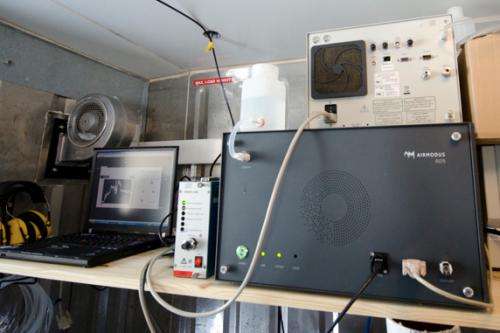February 22, 2013 report
Researchers discover birth process of a class of aerosols

(Phys.org)—A large multinational team of researchers, led by Markku Kulmala of Finland's University of Helsinki, has for the first time discovered the birth process of a class of aerosols. As they describe in their paper published in the journal Science, the team was able to view the building blocks of aerosols by constructing an ultra-sensitive aerosol-particle detector and analyzing the particles that were captured.
Aerosols are droplets that exist in the atmosphere that are made up of solids and liquids—they float because they are so small and light. Researchers study them because they are believed to play an important role in weather patterns—they form the seeds of cloud formation, for example, and have an impact on how much heat the atmosphere holds. But despite their importance, scientists still know very little about them, such as how they come about. Recent research has suggested that they actually form in the atmosphere, rather than wind up there after being carried aloft. Now, for the first time, a team of researchers has managed to capture the building blocks of a class of aerosols that are found in northern Europe.
If aerosols are born in the atmosphere, they must start out as something small first, the team theorized, and then grow to the size that is normally observed. To find out if this was correct, they built an ultra-sensitive aerosol-particle detector and set it up in an isolated part of the Hyytiälä forest in Finland. In studying the tiniest particles detected, the researchers found that aerosols, at least in that part of the world, start out as clusters of sulfuric acid and organic molecules just a couple of nanometers in size—they appear to come into existence due to collisions between the two components. The team observed that the tiny clusters continued to grow very slowly, due to their neutral charge, until they reached a size of approximately 3 nanometers. Once that tipping point was reached, the clusters began growing much more quickly by amassing a coat of organic molecules.
Understanding how aerosols form is key to understanding the forces that are at play in our atmosphere and ultimately to explaining definitively what is driving global warming. For that reason, samples from other parts of the planet will be taken in the near future to see if the basic building blocks are the same in other locations and to note if differences between them have different impacts.
More information: Direct Observations of Atmospheric Aerosol Nucleation, Science 22 February 2013: Vol. 339 no. 6122 pp. 943-946. DOI: 10.1126/science.1227385
ABSTRACT
Atmospheric nucleation is the dominant source of aerosol particles in the global atmosphere and an important player in aerosol climatic effects. The key steps of this process occur in the sub–2-nanometer (nm) size range, in which direct size-segregated observations have not been possible until very recently. Here, we present detailed observations of atmospheric nanoparticles and clusters down to 1-nm mobility diameter. We identified three separate size regimes below 2-nm diameter that build up a physically, chemically, and dynamically consistent framework on atmospheric nucleation—more specifically, aerosol formation via neutral pathways. Our findings emphasize the important role of organic compounds in atmospheric aerosol formation, subsequent aerosol growth, radiative forcing and associated feedbacks between biogenic emissions, clouds, and climate.
Journal information: Science
© 2013 Phys.org



















